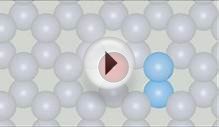I’m working on the fundamental building blocks of each digital circuits, namely transistors. In contrast to full circuit-level simulations, which deal with the interaction of many transistors, my focus is on a better understanding and a more predictive simulation of a single transistor. The drift-diffusion model has been the method of choice for several decades, yet it fails to describe modern, scaled-down devices. My approach is to solve the semiclassical Boltzmann equation using the deterministic spherical harmonics expansion method instead, which provides the accuracy of Monte Carlo methods at a fraction of the computational expense.
The Boltzmann transport equation (BTE) for semiconductor is the governing equation for the carrier distribution function , where is the spatial variable, is the particle momentum, and is time. In other words, the probability density for finding a particle at location with momentum at time is given by . Hence, a solution of the Boltzmann transport equation provides much more insight and better modeling possibilities as compared to standard macroscopic models, where only macroscopic values such as the electron density are available. The price to pay, however, is the higher dimensionality due to the momentum variable: For a full three-dimensional device simulation of e.g. a FinFET, the seven-dimensional BTE needs to be solved.
Traditionally, the Monte Carlo method was used to solve the BTE approximately by tracking the motion of randomly injected particles inside the device. Macroscopic quantities such as electron densities are then obtained by sampling. There are, however, a couple of disadvantages of the Monte Carlo method, e.g.
- A large number of particles is required to resolve macroscopic quantities accurately, leading to high execution times.
- The method is transient by nature.
- Large signal analysis is essentially impossible because the time step cannot be chosen arbitrarily large.
To overcome the deficiencies of Monte Carlo methods, various deterministic solution approaches were developed. Among these, the spherical harmonics expansion (SHE) method has received the most attention and is presumably the most mature. Similar to solution techniques based on truncated Fourier series, the distribution function is expanded into spherical harmonics with respect to the angular components of the momentum:
Here, the momentum is decomposed into its modulus via the kinetic energy , and into the angular components via the angles , with referring to kinetic energy. An exact representation of is obtained if the expansion order is chosen to be infinity. For practical purposes, one finds that already gives good results, while up to may be required under certain high-stress conditions. Among other extensions of the method, my supervisors and I developed a scheme that allows the expansion order to vary across the device and use high expansion orders only where necessary. An implementation can be found in the free open-source device simulator ViennaSHE.
RELATED VIDEO
